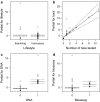Cryptic speciation in the Acari: a function of species lifestyles or our ability to separate species?
- PMID: 26209969
- PMCID: PMC4559570
- DOI: 10.1007/s10493-015-9954-8
Cryptic speciation in the Acari: a function of species lifestyles or our ability to separate species?
Abstract
There are approximately 55,000 described Acari species, accounting for almost half of all known Arachnida species, but total estimated Acari diversity is reckoned to be far greater. One important source of currently hidden Acari diversity is cryptic speciation, which poses challenges to taxonomists documenting biodiversity assessment as well as to researchers in medicine and agriculture. In this review, we revisit the subject of biodiversity in the Acari and investigate what is currently known about cryptic species within this group. Based on a thorough literature search, we show that the probability of occurrence of cryptic species is mainly related to the number of attempts made to detect them. The use of, both, DNA tools and bioassays significantly increased the probability of cryptic species detection. We did not confirm the generally-accepted idea that species lifestyle (i.e. free-living vs. symbiotic) affects the number of cryptic species. To increase detection of cryptic lineages and to understand the processes leading to cryptic speciation in Acari, integrative approaches including multivariate morphometrics, molecular tools, crossing, ecological assays, intensive sampling, and experimental evolution are recommended. We conclude that there is a demonstrable need for future investigations focusing on potentially hidden mite and tick species and addressing evolutionary mechanisms behind cryptic speciation within Acari.
Figures


Similar articles
-
Cryptic species as a window into the paradigm shift of the species concept.Mol Ecol. 2018 Feb;27(3):613-635. doi: 10.1111/mec.14486. Epub 2018 Feb 16. Mol Ecol. 2018. PMID: 29334414 Review.
-
Host race formation in the Acari.Exp Appl Acarol. 2007;42(4):225-38. doi: 10.1007/s10493-007-9091-0. Epub 2007 Aug 3. Exp Appl Acarol. 2007. PMID: 17674128 Review.
-
Finding Evolutionary Processes Hidden in Cryptic Species.Trends Ecol Evol. 2018 Mar;33(3):153-163. doi: 10.1016/j.tree.2017.11.007. Epub 2017 Dec 11. Trends Ecol Evol. 2018. PMID: 29241941
-
Cryptic diversity impacts model selection and macroevolutionary inferences in diversification analyses.Proc Biol Sci. 2022 Nov 30;289(1987):20221335. doi: 10.1098/rspb.2022.1335. Epub 2022 Nov 16. Proc Biol Sci. 2022. PMID: 36382998 Free PMC article.
-
Cryptic species conservation: a review.Biol Rev Camb Philos Soc. 2025 Feb;100(1):258-274. doi: 10.1111/brv.13139. Epub 2024 Sep 5. Biol Rev Camb Philos Soc. 2025. PMID: 39234845 Free PMC article. Review.
Cited by
-
Phylogenetic Position of a New Trisetacus Mite Species (Nalepellidae) Destroying Seeds of North American Junipers and New Hypotheses on Basal Divergence of Eriophyoidea.Insects. 2022 Feb 15;13(2):201. doi: 10.3390/insects13020201. Insects. 2022. PMID: 35206774 Free PMC article.
-
Multi-Locus Sequence Analysis Indicates Potential Cryptic Speciation in the Chigger Mite Neoschoengastia gallinarum (Hatori, 1920) Parasitising Birds in Asia.Animals (Basel). 2024 Mar 21;14(6):980. doi: 10.3390/ani14060980. Animals (Basel). 2024. PMID: 38540077 Free PMC article.
-
Genetics of lineage diversification and the evolution of host usage in the economically important wheat curl mite, Aceria tosichella Keifer, 1969.BMC Evol Biol. 2018 Aug 7;18(1):122. doi: 10.1186/s12862-018-1234-x. BMC Evol Biol. 2018. PMID: 30086701 Free PMC article.
-
A New Aculodes Species (Prostigmata: Eriophyidae) Described from an Invasive Weed by Morphological, Morphometric and DNA Barcode Analyses.Insects. 2022 Sep 27;13(10):877. doi: 10.3390/insects13100877. Insects. 2022. PMID: 36292824 Free PMC article.
-
A comprehensive survey of the prevalence and spatial distribution of ticks infesting cattle in different agro-ecological zones of Cameroon.Parasit Vectors. 2019 Oct 17;12(1):489. doi: 10.1186/s13071-019-3738-7. Parasit Vectors. 2019. PMID: 31623642 Free PMC article.
References
-
- Arthur AL, Miller AD, Weeks AR. Genetic markers indicate a new species complex of emerging pest mites in Australian grains. Ann Entomol Soc Am. 2011;104:402–415. doi: 10.1603/AN10065. - DOI
-
- Baker AS, Schwarz HH. Morphological differences between sympatric populations of the Poecilochirus carabi complex (Acari: Mesostigmata: Parasitidae) associated with burying beetles (Silphidae: Nicrophorus) Syst Parasitol. 1997;37:179–185. doi: 10.1023/A:1005822702267. - DOI
Publication types
MeSH terms
LinkOut - more resources
Full Text Sources
Other Literature Sources

